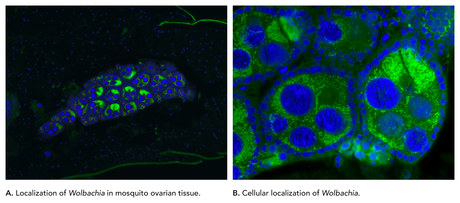Bacterial biocontrol for Zika virus

The Eliminate Dengue Program is developing a natural method for controlling mosquito-transmitted diseases such as dengue and chikungunya. Now, the program’s Brazilian project team is using the method to control the spread of Zika virus (ZIKV).
Led by Dr Luciano Moreira (FIOCRUZ — Centro de Pesquisas René Rachou), the researchers are infecting mosquitoes with naturally occurring bacteria, called Wolbachia, that reduce the ability of the mosquitoes to transmit the disease-causing virus to humans. Wolbachia occurs naturally in up to 60% of all insect species and is passed to new generations during reproduction.
“One of the most important features of our project is how sustainable it is,” noted Dr Moreira. “After we release Wolbachia-infected mosquitoes into an area over the period of a few months, they increase and maintain their prevalence naturally without us having to continually release more mosquitoes.”
Dr Moreira’s team uses ZEN Double-Quenched Probes from Integrated DNA Technologies (IDT) to monitor the persistence of viruses within the mosquito population. Their recent research shows that by dispersing Wolbachia-infected mosquitoes, they can significantly reduce risk of transmission of ZIKV and dengue virus. Now IDT is donating reagents to Eliminate Dengue Brazil so that additional research can be completed quickly and efficiently.
“IDT is committed to sponsoring innovative research that drives medical, agricultural and environmental advances,” said IDT founder and CEO Dr Joseph A Walder. “We are proud to be able to support the work being done by Eliminate Dengue Brazil to reduce Zika virus transmission. This is an important global issue being addressed using a natural, sustainable and safe method.”
Females found to carry a higher genetic risk of depression
An international team of scientists has discovered about twice as many genetic 'flags'...
Widespread resistance to common antibiotics is increasing: WHO
Increasing resistance to essential antibiotics poses a growing threat to global health, with one...
Dopamine helps our brains to let go of memories
In a discovery that could reshape how we think about memory, researchers at Flinders University...







